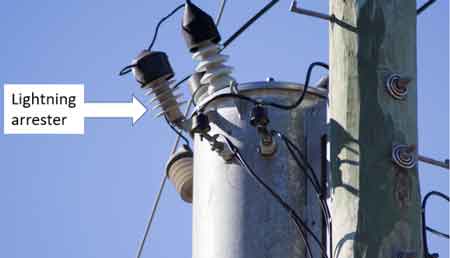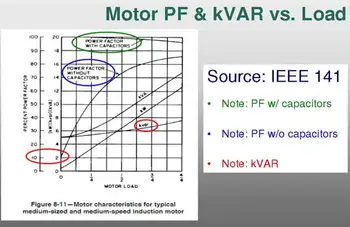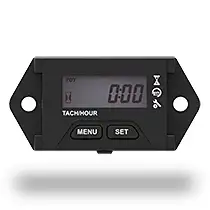Lightning Arrester Explained

Power Factor Training
Our customized live online or in‑person group training can be delivered to your staff at your location.

- Live Online
- 6 hours Instructor-led
- Group Training Available
Download Our OSHA 3875 Fact Sheet – Electrical PPE for Power Industry Workers

- Follow rules for rubber gloves, arc-rated PPE, and inspection procedures
- Learn employer obligations for testing, certification, and training
- Protect workers from arc flash and electrical shock injuries
A lightning arrester protects electrical systems by diverting high-voltage surges from lightning strikes to the ground. It prevents equipment damage, ensures system reliability, and enhances safety in power transmission and distribution networks.
What is a Lightning Arrester?
A lightning arrester is a vital protective device in electrical power distribution systems, shielding sensitive equipment from the devastating effects of lightning strikes. It:
✅ Protects electrical equipment from high-voltage lightning surges.
✅ Safely redirects surge energy to the ground.
✅ Enhances system reliability and power grid safety.
Power Quality Analysis Training
Request a Free Power Quality Training Quotation
These strikes can generate immense voltage surges, capable of damaging transformers, insulators, and other critical components. For T&D professionals, understanding how it works is crucial to ensuring the reliability and safety of power networks. This article examines the fundamental aspects of lightning arresters and their crucial role in protecting our electrical infrastructure. Lightning arresters work in conjunction with proper electrical grounding to ensure that surge energy is safely diverted into the ground.
Surge Protection: Taming the Lightning Surge
Surge protection is the primary function of a lightning arrester. When lightning strikes a power line, it injects a massive surge of electrical energy, known as a lightning surge, into the electrical system. This surge can propagate through the power lines, reaching connected equipment and causing irreparable damage. They act as safety valves, diverting this excess energy away from valuable assets and safely channelling it into the ground. This diversion prevents costly repairs and outages, ensuring the continuity of power supply to consumers. Surge events often generate transient voltage, which can damage transformers, switchgear, and sensitive electronics.
Overvoltage Protection: Shielding Against Electrical Stress
Overvoltage protection is another critical role that the lightning arrester plays. While lightning strikes are a major cause of overvoltages, other events, such as switching operations and system faults, can also generate voltage spikes. These high-voltage transients can stress the insulation of electrical equipment, leading to premature failure and costly downtime. By limiting the voltage levels experienced by equipment, lightning arresters act as a safeguard, extending the lifespan of transformers, switchgear, and other vital components within the power distribution network. Engineers frequently analyze inrush surge current when designing protective systems to manage sudden voltage spikes.
Test Your Knowledge About Power Quality!
Think you know Power Quality? Take our quick, interactive quiz and test your knowledge in minutes.
- Instantly see your results and score
- Identify strengths and areas for improvement
- Challenge yourself on real-world electrical topics
Transient Voltage Suppressor (TVS): Enhancing Protection
Transient Voltage Suppressors (TVSs) are semiconductor devices often used in conjunction with lightning arresters to provide an additional layer of protection against voltage transients. While they normally handle larger surges, TVSs excel at clamping fast, high-frequency transients that might slip through the primary protection. This combined approach ensures comprehensive protection against a wide range of voltage disturbances, further enhancing the resilience of the power distribution system. What is surge suppression, and how does it complement lightning arresters? Both work to mitigate harmful voltage spikes.
Metal Oxide Varistor (MOV): The Core of the Lightning Arrester
The heart of most modern arresters is the Metal Oxide Varistor (MOV). This ceramic device has a unique electrical behaviour. Under normal operating voltages, it acts as an insulator, preventing the flow of current. However, when a high-voltage surge appears, the MOV instantly becomes a conductor, providing a low-resistance path for the surge current to flow to ground. This rapid response effectively clamps the voltage and protects the connected equipment. To maintain power quality, utilities must monitor power quality and harmonics, ensuring that protective devices like arresters operate effectively.
Insulation Coordination: A System-Wide Approach
Insulation coordination is a critical aspect of power system design that ensures the proper selection of insulation levels for various components. The lightning arrester plays a vital role in this process. By limiting the magnitude of overvoltages, they help prevent insulation breakdown and ensure the coordinated operation of protective devices. This coordinated approach minimizes the risk of cascading failures and ensures the overall stability of the power distribution network. A comprehensive grounding system combined with lightning arresters improves the overall reliability of power distribution networks.
Frequently Asked Questions
How does a lightning arrester work?
They function by diverting surge currents, such as those caused by lightning strikes, away from sensitive equipment and safely into the ground. This is achieved through the use of components like Metal Oxide Varistors (MOVs), which change their conductivity in response to voltage surges, providing a low-resistance path for the excess current to flow to the ground.
Where should a lightning arrester be installed?
Placement of the lightning arrester is crucial for its effectiveness. They are typically installed near the equipment they are intended to protect, such as transformers, switchgear, and motors. In power distribution systems, they are commonly found at substations, along power lines, and near customer premises.
What are the different types of lightning arrester?
They are categorized based on various factors, including voltage level, application, and technology. Common types include distribution class arresters for overhead lines, station class arresters for substations, and specialized arresters for specific equipment, such as transformers and cables.
How do I choose the right lightning arrester?
Selecting the appropriate one involves considering factors like system voltage, the level of protection required, environmental conditions, and relevant standards. Consulting with experts and referring to manufacturer specifications are crucial steps in making the right choice.
How do I know if my lightning arrester is working?
Regular inspection and testing are essential to ensure proper functioning. Visual checks for signs of damage, along with periodic electrical testing, can help determine if an arrester is operating correctly or needs replacement.
A lightning arrester is an indispensable component in electrical power distribution systems, providing crucial protection against the damaging effects of lightning strikes and voltage surges. By diverting surge currents to the ground and limiting overvoltages, they safeguard valuable equipment, prevent outages, and ensure a reliable electricity supply to consumers. Understanding the different types of arresters, their placement, and their operating principles is essential for electrical professionals in maintaining the integrity and resilience of power networks. Through proper selection, installation, and maintenance, it can contribute significantly to the safe and efficient operation of our critical electrical infrastructure.
Sign Up for Electricity Forum’s Power Quality Newsletter
Stay informed with our FREE Power Quality Newsletter — get the latest news, breakthrough technologies, and expert insights, delivered straight to your inbox.








